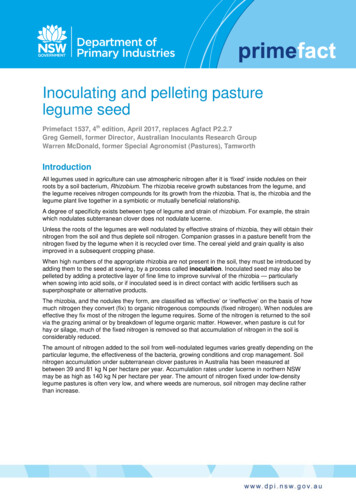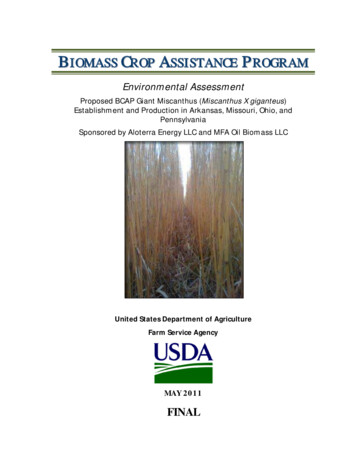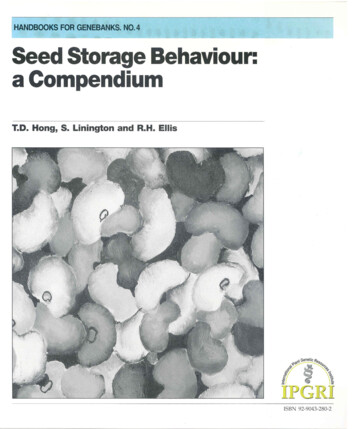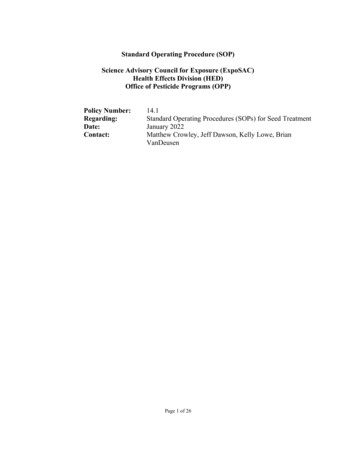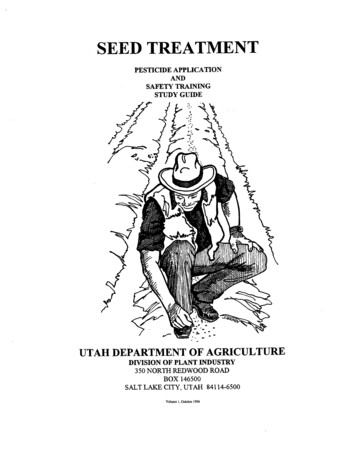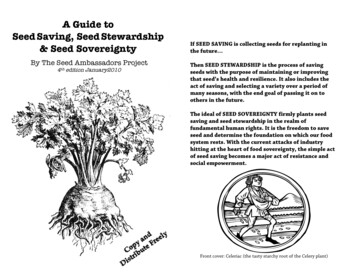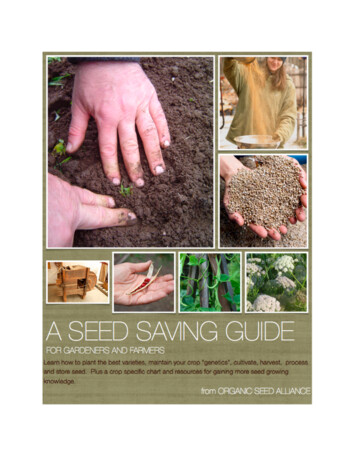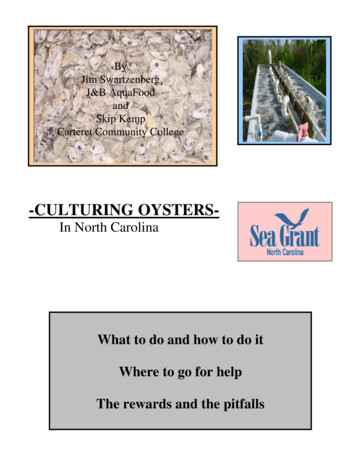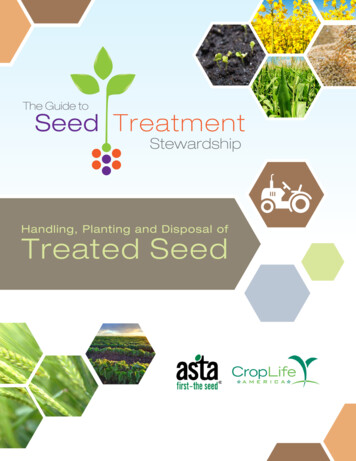
Transcription
Handling, Planting and Disposal ofTreated Seed
Handling, Planting and Disposal of Treated SeedDISCLAIMERThe Seed Treatment Stewardship Guide is intended solely as an educational tool and as generalguidance to assist growers in voluntarily developing and implementing stewardship practicesrelated to the use of treated seed. This Guide is intended to serve as a reference document only.Entities may choose to refer to the entire Guide or specific sections of the Guide as appropriate. Theguidance is intended to be flexible, and its application will differ according to the products involvedand size, nature and complexity of the entity using the guidance. The Guide is representative and notexhaustive.It is the responsibility of any user of this document to consider that user’s specific circumstances in1) developing a stewardship plan specific to its business; and 2) meeting any applicable legal andregulatory requirements. This Guide is not intended as, and should not be construed as, legal adviceor a substitute for a user’s own individual understanding of applicable legal requirements. Regulatoryrequirements may be issued or revised by government agencies after the publication date ofthis Guide. Users are advised to consult with their legal counsel and/or contact the appropriateregulatory agency or agencies to ensure compliance with applicable requirements.The Guide does not define or create legal rights or obligations, and the American Seed TradeAssociation (ASTA) and Crop Life America (CLA) specifically disclaims any such rights or obligations.ASTA, CLA and their respective members do not make any warranties or representations, eitherexpressed or implied, with respect to the accuracy or completeness of the information containedin this Seed Treatment Stewardship Guide; nor do they assume any liability of any kind whatsoeverresulting from the use of or reliance upon any information, procedures, conclusions or opinionscontained in this Guide.2
Handling, Planting and Disposal of Treated SeedOverview of Seed TreatmentSeed Treatments as a Part of U.S. AgricultureThe use of seed treatment technologies by farmers is an effective tool to provide the necessaryprotection of seeds for a strong, healthy start. Using seed treatments delivers a very preciseapplication that shields seeds from the insects and diseases that exist in the soil during thoseearly developmental stages. This protection ensures that the plant has a greater opportunityto grow a strong root system which is the foundation of a healthy, productive plant.In addition, seed treatments reduce theenvironmental impact of the production processby decreasing the number of spray applications ofagrichemical products and lessening exposuresto non-target species, including humans andpollinators. Seed treatments can guard againstinsect or disease damage during a plant’s mostvulnerable developmental stages and helpmaximize the performance potential of each seed.The industry is constantly evolving to improveseed treatment processes. Seed treatments havebeen used for decades and thanks to advances inthe technology, only milligrams of active ingredientare now used per individual seed.Definition ofSeed TreatmentSeed treatment is the application ofbiological organisms/products and chemicalingredients to seed to suppress, control,or repel plant pathogens, insects, or otherpests that attack seeds, seedlings or plants.Other products such as inoculants, herbicidesafeners, micronutrients, plant growthregulators, seed coating materials, colorants,etc. may also be applied to the seed. Treatedseed is intended for planting and may not beused for food, feed, or oil purposes.This Guide is geared specifically to those whoplant treated seed. If you are planning to treat seed,refer to the ASTA-CLA Guide to Seed Treatment Application.HighlightsIt is essential to educate those who treat, handle, transport and plant the seed to helpensure that seed treatment solutions result in success for everyone involved. Some of thecritical factors that growers need to consider when using treated seed are:1. F ollow the label directions for proper handling and storage practices for a pesticidetreated product.2. B e aware of wind direction and speed and the presence of foraging pollinators, hivelocations, flowering habitats including weeds and other plants at field edges or nearby,and aquatic habitats.3. Properly dispose of treated seed and empty seed containers.4. Ensure no treated seed enters the commodity grain channels.3
Handling, Planting and Disposal of Treated SeedSE C T IO N 1 :Safe Handling and Transport of Treated SeedsI.Personal Protection Equipment (PPE)W hen selecting PPE, always read and follow treated seed tag safety language. PPEtypically includes long pants, long sleeved shirt/coveralls, chemical resistant gloves,shoes and socks, etc.R eference required or suggested PPE as indicated by equipment manufacturers foroperation of equipment used to handle, transport, and plant treated seed. AdditionalPPE may include eye, ear, respiratory, foot, and/or head protection.II. Transporting Treated SeedR ead and understand seed treatment tag language and follow requirements thatare printed on or attached to the treated seed containers or contained in shippingdocuments for bulk treated seed.N ote manufacturer or seed company phone number for specific product questions.Also note any emergency or medical center contact information.Protect treated seed from direct sunlight, extreme heat and moisture.Avoid undue mechanical abrasion and damage to the treated seed and packagingcontainers to minimize dust and spillage and maintain seed quality. In case of spills, collect the treated seed immediately using proper PPE . Properly dispose of spillage to minimize exposure to people, livestock, wildlife,and the environment.III. Handling Treated SeedA void exposure to dust when opening/emptying packaging or transferring bulktreated seed.P roperly dispose of any spillage to minimize exposure to people, livestock, wildlifeand the environment.Handlers should be aware of all seed treatment safety and stewardship taglanguage.4
Handling, Planting and Disposal of Treated SeedSE C T IO N 2 :Storage of Treated SeedsR ead the seed treatment tag language to understand specific treated seed storagerequirements.T reated seed should be protected from direct sunlight, extreme heat and moisture. Thefacility should also be well ventilated.T reated seed should be kept secure from children, livestock, wildlife and unauthorizedpersons.SE C T IO N 3 :Planting of Treated SeedI.Use of Seed-flow LubricantsFollow recommendations from planter manufacturers for use of talc, graphite orother fluency agents or lubricants.Avoid excess use rates of lubricants to minimize dust and to avoid buildup ofunwanted residue.II. PlantingI dentify the potential pest or disease before selecting seed treatments based onhistorical or other information.Read and understand planting instructions found on seed treatment tags and followplanting requirements that are printed on or attached to the treated seed bags and/or containers or contained in shipping documents for bulk treated seed.Survey for the presence of pollinator hives and flowering crops or weeds in the fieldto be planted, in field borders and nearby, which could attract pollinators.Eliminate flowering plants and weeds in and immediately adjacent to the field prior toplanting seeds treated with a pollinator sensitive insecticide.Avoid dust drift from treated seeds to sensitive areas during planting by observingwind speed and direction.A lways use high quality seed, free from excessive dust.F ollow manufacturer recommendations/procedures for calibration, operation andmaintenance as specified in the planter operator manual.For pneumatic planters, direct air exhaust downward towards the soil surface ifpossible to decrease the potential of dust drift.5
Handling, Planting and Disposal of Treated SeedThe use of downward deflectors may decrease drift of dust.T he planter should be filled at least 10 yards inside the field to be planted, avoidingproximity to pollinator hives, hedges or flowering crops or weeds.When opening seed containers or when filling and emptying the planter, positionyourself upwind to avoid any released dust.A void shaking the bottom of the seed bag when filling the planter to reduce releaseof any dust that may have accumulated during transport.W hen using planter box treatments, consult with the manufacturer to ensure theproduct will not increase abrasion and drift of treated seed products.A lways plant the treated seed at the recommended seeding rate and depth as listedon the seed tag.E nsure all seed is covered by soil to protect wildlife and the environment.F ollow plant back restrictions found on the seed tag or referenced elsewhere.D ispose of seed packaging and/or containers in accordance with local requirementsand container return policies.III. Cleaning of Planting EquipmentIt is not recommended to use transport and conveyance equipment for bulk treatedseed for the harvested commodity. If used, the equipment must be disassembled,kernel cleaned, and all residue removed from all surfaces by scraping, vacuumingand washing of all surfaces. There is zero tolerance for treated kernels in thecommodity grain channel when the treated seed tag states the seed is not for food,feed, or oil purposes.C lean planters and seed boxes away from sensitive environmental areas. Be awareof and avoid those areas that are attractive to pollinators, such as field margins withflowering crops or weeds, and/or near hive locations.D o not use compressed air as it may lead to significant dust drift.You may apply excess rinse water from the cleaning of planting equipment to afield for which the active ingredient is registered if it will not result in an appliedconcentration above the label recommendation.D o not dump rinse water on soil, surface water, ground water, or in septic systems.6
Handling, Planting and Disposal of Treated SeedSE C T IO N 4 :Disposal of Excess Treated SeedsI.Small Quantities of Pesticide-Treated SeedReturn excess treated seed to its original seed lot containers if the seed is intendedfor storage and subsequent planting.Plant in fallow or other non-cropped areas of the farm in accordance to the seedtreatment product label.Unless restricted by label language, excess treated seed may be double planted inthe turn rows at the end of the field or within a portion of the field.II. Off Farm Disposal of Seed Not Acceptable for Planting and/or LargerQuantities of Pesticide Treated SeedC onsult with your state and local authorities to ensure your disposal plan is incompliance with all appropriate regulations.D isposal facilities will be required to have an EPA permit to accept pesticide treatedseed. Whether a waste management facility, power plant, cement kiln, ethanol plant,or municipal landfill is permitted to dispose of seed treated with a particular pesticidecan only be confirmed by contacting the facility. Your seed supplier may also beaware of EPA permitted disposal facilities in your area.T he contacts for both solid and hazardous waste disposal in each state can befound here.There is zero tolerance for treated seed kernels in the commodity grain channelwhen the treated seed tag states the seed is not for food, feed, or oil purposes.7
Handling, Planting and Disposal of Treated SeedRE S O UR C E S :Disclaimer:The external links provided in this guide are intended for use as additional, externalsupplementary resources for the reader. Neither the American Seed Trade Associationnor CropLife America can be held liable for the information found outside the scope ofthis document.EPA linksClick on iconto visit linkEnvironmental Protection Agency GeneralEnvironmental Protection Agency – Label Review Manual – Chapter 18: Unique ProductPesticide LabelingApply Pesticides Correctly, a Guide for Commercial ApplicatorsWastes-Hazardous WastesFederal Insecticide, Rodenticide and Fungicide Act (FIFRA)F ederal Regulation Title 40 – Protection of Environment, Chapter I – EnvironmentalProtection Agency, Subchapter I-Solid Wastes, Part 261 Identification and listing ofHazardous WasteState Sites for Solid and Hazardous WasteUSDA linksUSDA Home pageAgricultural Marketing Service-Seed Regulatory and Testing Services8
Handling, Planting and Disposal of Treated SeedSeed Law/RegulationsFederal Seed Act (FSA)State Seed LawsAssociation of American Pesticide Control OfficialsAssociation of American Seed Control OfficialsClick on iconto visit linkRecommended Uniform State Seed Law (RUSSL)Stakeholder ResourcesThe American Association of Pesticide Safety EducatorsC ertification & Training Assessment Group – National Partnership for Safe& Effective Pesticide ManagementDisposal ResourcesThe Cement Kiln Recycling CoalitionLabeling linksCDMSAgrian9
Handling, Planting and Disposal of Treated SeedAssociation ResourcesAg Retailers AssociationAmerican Seed Trade AssociationAssociation of American Pesticide Control OfficialsAssociation of American Seed Control OfficialsAssociation of Equipment ManufacturersCropLife AmericaNational Association of State Departments of Agriculturewww.seed-treatment-guide.comClick on iconto visit link
The Seed Treatment Stewardship Guide is intended solely as an educational tool and as general guidance to assist growers in voluntarily developing and implementing stewardship practices related to the use of treated seed. This Guide is intended to serve as a reference document only.


